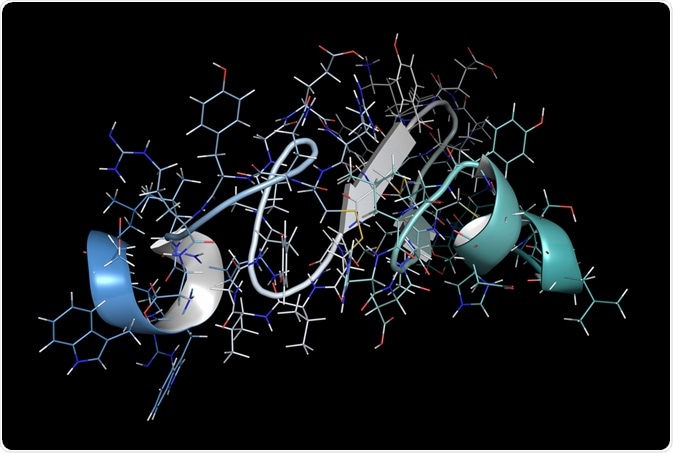GDF15 (growth differentiation factor 15) is an established biomarker of cellular stress. Research indicates that almost any cell or tissue types produces GDF15 in response to various forms of stress1. For this reason, it is starting to be used in clinical practice as a diagnostic biomarker in mitochondrial disease and as a prognostic marker in conditions such as heart failure and certain cancers2-4.
It also plays a role in nutrition, but the nutritional states that signal production of GD15 have not been fully elucidated.

© molekuul_be/Shutterstock.com
GDF15
The stress-induced cytokine GDF15 (growth differentiation factor 15; also known as macrophage inhibitory cytokine-1) is an atypical member of the transforming growth factor beta superfamily. It circulates at high levels in humans, with the majority of its expression occurring in the liver, lung, kidney and placenta.
Serum levels have been shown to increase with age, smoking, intense exercise, cancer, and a range of other disease states5.
GDF15 exerts its effects via a specific receptor in the hindbrain. This receptor is related to the GDNF (Glial cell-derived neurotrophic factor) receptor alpha (GFRa) family, and so is referred to as the GFRa-like or GFRAL receptor. Stimulation results in reduced food intake.
Mice lacking GDF15 or having a GFRAL defect have been found to develop diet-induced obesity, which suggested that GDF15 may play a physiological role in energy balance.
GD15 and nutrition
A variety of studies have been conducted in mice to explore the role of GD15 in nutrition. Mice models designed to overexpress GDF15 were shown to lose weight dramatically and the same effect could be achieved in healthy mice by injection of recombinant GDF15. The action of GD15 has also been effectively prevented by injecting a GDF15 neutralizing antibody.
Although it is clear that GD15 exerts anorexigenic effects, it has not been determined whether sustained overfeeding causes an increase in circulating levels of GDF15 or which tissues are responsible.
Recent research investigated how changes in nutritional state affected the expression of GDF156. In addition, elements of the cellular integrated stress response (ISR) that are involved in the regulation of GDF15 expression were studied. The ISR is a cell-autonomous integrator of diverse cellular stresses.
In the mouse study, male mice pups aged 9 weeks were fed a diet of either standard chow or a high fat diet for 18 weeks. All mice were weighed weekly and body composition was determined every 4 weeks by time-domain nuclear magnetic resonance (TD-NMR) using a Bruker Minispec LF series NMR spectrometer.
A variety of human studies were conducted in healthy volunteers and obese volunteers who followed different dietary regimes, eg, calorie deprivation, short-term high-fat over-feeding. The effects were determined through analysis of regular blood samples.
In both mouse and human studies, very little change in the circulating levels of GDF15 were observed in response to moderate caloric surpluses or deficits. This is in sharp contrast with the classic intestinal hormones and leptin that are produced in response to satiety.
However, although GDF15 production was not promoted by meals or periods of moderate caloric deficit or caloric excess, increased GDF15 levels were measured after sustained intake of a diet high in fat or with an amino acid imbalance in mice.
Mice receiving a high-fat diet were exhibited activation of the ISR in some tissues. In addition, acute administration of GDF15 elicited an aversive taste response in mice. This suggests that GDF15 may induce an aversion to certain foods in order to correct nutritional stress.
In summary, the latest data demonstrate that GDF15 expression is regulated by the integrated stress response and is induced in selected tissues. Dietary changes influencing adipose/gut-derived hormones do not alter GDF15 levels, but chronic high-fat or acute lysine-deficient diet exposure induces ISR and increases GDF15 levels. In addition, GDF15 administration was shown to trigger conditioned taste aversion in mice.
GDF15 is a stress-induced hormone that may mediate an aversive dietary response
References
- Chung H-K, et al. J. Cell Biol. 2017;216:149-165.
- Wollert KC, et al. Clin. Chem. 2017;63:140-151.
- Fujita Y, et al. Geriatr. Gerontol. Int. 2016;16(Suppl 1):17-29.
- Wang X, et al. Biochem. Pharmacol. 2013;85:597-606.
- Corre J, et al. Stem Cells Transl. Med. 2013;2:946-952.
- Patel S, et al. Cell Metabolism 2019;29(3):707‑718. https://doi.org/10.1016/j.cmet.2018.12.016
About Bruker BioSpin - NMR, EPR and Imaging

Bruker BioSpin offers the world's most comprehensive range of NMR and EPR spectroscopy and preclinical research tools. Bruker BioSpin develops, manufactures and supplies technology to research establishments, commercial enterprises and multi-national corporations across countless industries and fields of expertise.
Sponsored Content Policy: News-Medical.net publishes articles and related content that may be derived from sources where we have existing commercial relationships, provided such content adds value to the core editorial ethos of News-Medical.Net which is to educate and inform site visitors interested in medical research, science, medical devices and treatments.